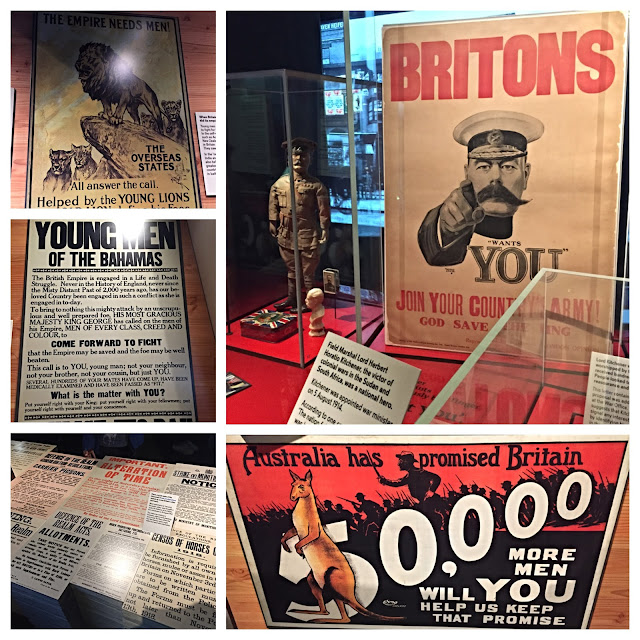The Imperial War Museum and the Great War
With another free week before my classes start, this past Tuesday, I visited one of my all time favorite museums in London: The Imperial War Museum (IWM). As the title implies, this is a museum dedicated to military conflict within the realm of British history, though it's main focus is World War I to the present day.
I wanted to visit this museum last summer, when I was in London, but sadly, it was closed for renovations. With time on my hands and learning that I lived 15 minutes away walking, I was eager to see what changes had been made to the museum.
When I walked in, it was like I was in a completely different museum! The architecture was much more modern and sleek, making use of white and silver, and the displays in the foyer were much more impressive. The ceiling of the museum played host to a variety of air planes, whilst the ground hosted land vehicles and the remains of weapons. Quite an entrance!
In addition to the trench signs, my second favorite display was the Zimmerman Telegram. Over the past year or so, I have developed a deep fascination, bordering obsession, with the Zimmerman Telegram. In my opinion, the Zimmerman Telegram is one of the most important things to happen during World War I because it's the reason why the United States declared war on Germany. To quote my own lecture notes from my November 2014 lecture at NYMAS:
"It wasn't until early 1917, when Room 40 [Britain's military intelligence agency] intercepted a message from Germany destined for Mexico. The telegram was a diplomatic proposal form the German Empire to Mexico, asking Mexico to attack the United States in the name of the Central Powers. If the invasion was successful, Germany intended to reward Mexico with the territories taken by the United States during the Mexican American War. Britain managed to acquire this telegram and once Britain passed this message to the US, President Wilson then declared war on Germany on April 9, 1917."
Granted, this is a vast oversimplification of this complicated event, but that's generally what happened and when I saw this document on display, I had a really nerdy history fan girl moment. It was glorious!
I wanted to visit this museum last summer, when I was in London, but sadly, it was closed for renovations. With time on my hands and learning that I lived 15 minutes away walking, I was eager to see what changes had been made to the museum.
When I walked in, it was like I was in a completely different museum! The architecture was much more modern and sleek, making use of white and silver, and the displays in the foyer were much more impressive. The ceiling of the museum played host to a variety of air planes, whilst the ground hosted land vehicles and the remains of weapons. Quite an entrance!
I took this picture from the 2nd floor, to give you a sense of what the entrance of the IWM looks like
There was so much to see, but I didn't necessarily want to do the entire museum in one go, so I decided to choose one or two sections to cover and then return in future to view the rest. That makes sense, right? On this first visit to the museum, I made a bee line towards the newly revamped World War I exhibit.
I must've spent at least two hours in this exhibit! It was really well done and so detailed! I was impressed by not only the amount of time and effort that went into researching the exhibit, but also, the careful thought that was put into how to design the exhibition, how to engage the public, and make this critical history accessible. Well done, IWM and whomever was involved!
From the moment I entered the exhibit, I was sucked in. Like Alice falling down the rabbit hole, I find myself transported to a world immersed in the Great War. From start to finish, I couldn't tear my eyes away from the placards, the displays, and the interactive screens. My head was spinning with all of the information that was bring absorbed. I did my very best to read everything I could, but after a while, fatigue set in and I became a bit overwhelmed by the sheer volume of information presented. Still, I thoroughly enjoyed the exhibit overall.
Interactive map and newspapers explaining the origins and events leading up to the Great War
Russian, German, and Austro-Hungarian uniforms
Below, you will find one of my favorite parts of the exhibit, which is a selection of trench signs. World War I tends to evoke images of trench warfare, which is appropriate, since that was a major cornerstone of this military conflict. Men would spend days, weeks, months, in trenches, waiting for something to happen. It was a miserable existence and a hazardous one too. Over time, elaborate networks of trenches were built and eventually became maze like. In order to navigate, trench signs were developed to help guide soldiers through the elaborate trench network. Some signs were designed to guide soldiers to safety and remind them of home (ex: Piccadilly Circus), whilst other signs warned soldiers of particularly dangerous areas of the trench (ex: Hell Fire Corner). I found this display thoroughly fascinating, but also incredibly haunting.
Trench signs
Wartime propaganda posters
More propaganda posters
The vast British Empire
Throughout the exhibit, the IWM left pertinent and emotional quotes, which complimented whatever was on display and/or was being discussed. Below, I have created a collage of the ones I found most memorable, though there were many.
In addition to the trench signs, my second favorite display was the Zimmerman Telegram. Over the past year or so, I have developed a deep fascination, bordering obsession, with the Zimmerman Telegram. In my opinion, the Zimmerman Telegram is one of the most important things to happen during World War I because it's the reason why the United States declared war on Germany. To quote my own lecture notes from my November 2014 lecture at NYMAS:
"It wasn't until early 1917, when Room 40 [Britain's military intelligence agency] intercepted a message from Germany destined for Mexico. The telegram was a diplomatic proposal form the German Empire to Mexico, asking Mexico to attack the United States in the name of the Central Powers. If the invasion was successful, Germany intended to reward Mexico with the territories taken by the United States during the Mexican American War. Britain managed to acquire this telegram and once Britain passed this message to the US, President Wilson then declared war on Germany on April 9, 1917."
Granted, this is a vast oversimplification of this complicated event, but that's generally what happened and when I saw this document on display, I had a really nerdy history fan girl moment. It was glorious!
Copies of the intercepted Zimmerman Telegram (R) and the decoded/translated message (L)
British nurse's uniform and British soldier's uniform
Getting a sense for what fighting in a trench would've been like
Model of the famed Red Baron's plane
Painting depicting the Treaty of Versailles, which officially ended the Great War
I won't lie, I was knackered by the time I had gotten to the end of the exhibit. Trying to read every piece of information provided was exhausting and towards the end, I started to lose steam a bit. Still, I walked away far more knowledgable about the Great War compared to when I first entered the exhibit. I highly recommend this exhibit to everyone! It's really wonderful done.

















Comments
Post a Comment